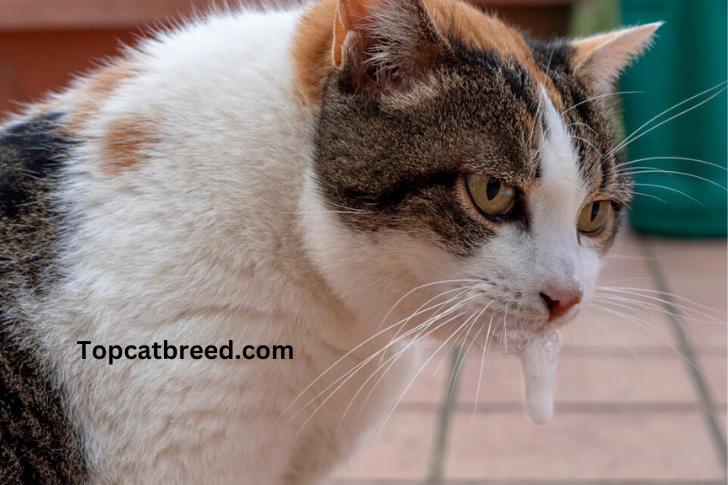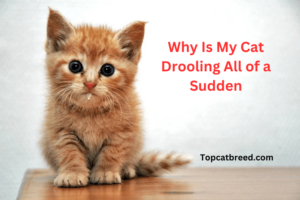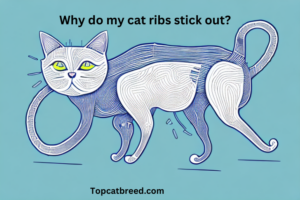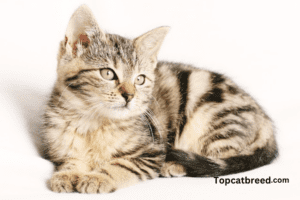Is your feline friend unexpectedly throwing up foam, leaving you concerned and curious? “Why is my cat throwing up foam?” is a common query among cat owners. There are several reasons for this strange behavior. Hairballs from your cat’s grooming routine and digestive problems are common causes. Dietary variables can also have a role, such as abrupt dietary changes or low-quality food. Foam vomiting can result from foreign items in the stomach and from cats’ natural curiosity. It’s essential that you understand these causes if you want to keep your cat healthy. And further reasons explained below in article so join with us.
This article explores seven possible causes of your cat’s foaming, highlighting possible health concerns and providing helpful advice on care and prevention. By identifying the underlying reasons, you can take proactive measures to maintain the wellbeing and health of your cat. Discover the complexities of feline health as we solve the puzzle of your beloved pet’s foam vomiting.
7 Reasons behind why is my cat throwing up foam?
1- Hairballs
One of the foremost reasons behind the query, “Why is my cat throwing up foam?” is the presence of hairballs. Cats, who are well-known for their close-grooming practices, engage in self-care routines in which they swallow loose fur. Unfortunately, hairballs can form because of the irregular passage of this ingested hair through the digestive tract. When these hairballs get too big to go through the cat’s intestines easily, they start to cause vomiting, which is frequently accompanied by a foamy material. Handling this prevalent feline problem requires careful considerations, such feeding them food designed to reduce hairballs and giving them regular brushing sessions to reduce loose hairs.
It becomes critical for cat owners to understand the nuances of hairballs in order to treat this particular source of foam-induced vomiting. Preventive care can make a big difference in your cat’s overall health, including adding specialty cat food that is made to reduce the creation of hairballs. Additionally, frequent brushing sessions—which are particularly important for long-haired breeds—work well to reduce loose fur and, as a result, lessen the chance of vomiting due to hairballs.
A happy and healthy cat-owner connection can be promoted by being aware of your feline friend’s grooming habits and taking preventative steps to deal with possible problems like hairballs. These actions also assure your feline companion’s comfort and well-being.
2-Gastrointestinal Issues
Second important reasons of Why is my cat throwing up foam is Gastrointestinal Issues. Like people, cats can suffer from a variety of digestive issues, such as gastritis and inflammatory bowel disease (IBD). These conditions cause the lining of the stomach to become inflamed and irritated, which makes cats feel uncomfortable and frequently causes them to throw up foam. Cat owners must take a complete and careful approach when treating gastrointestinal problems. A key component of treating these problems is making thoughtful changes to one’s diet, which may include using cat food designed specifically for sensitive stomachs. Veterinarian consultation is necessary if symptoms are persistent.
To ensure your cat’s general health, a comprehensive examination by a veterinarian is essential for an accurate diagnosis and the creation of customized treatments. Cat owners can take preventative measures to avoid and treat gastrointestinal disorders. Providing a well-balanced and easily digestible food promotes digestive health. Specialized cat chow for cats with sensitive stomachs may contain substances that help to relax the digestive tract. In addition, eating smaller, more frequent meals can put less load on the stomach, facilitating better digestion.
It is crucial to observe and note any changes in your cat’s behavior, such as frequent vomiting or changes in stool consistency. Early diagnosis of these indications allows for rapid veterinary intervention. Regular veterinary check-ups are also important for monitoring your cat’s overall digestive health and detecting possible problems before they develop.
3-Dietary Factors
The role of dietary factors in the question, “Why is my cat throwing up foam?” is paramount. Because they are creatures of habit, cats may be especially sensitive to sudden dietary changes or eating low-quality food, which can upset their stomachs and cause vomiting. Without a smooth transition, introducing new brands or components may cause digestive problems and the unpleasant behavior of vomiting foam.
It is necessary for cat owners to take a calculated and educated approach to reducing food-induced vomiting. It becomes crucial to give premium cat food that satisfies their nutritional needs as soon as possible. Choosing foods that are readily digested and well-balanced helps to maintain digestive health and reduces the risk of food-induced vomiting. Sustaining a regular feeding schedule also helps to keep the digestive tract of the cat stable. Providing dietary changes progressively is an important part of promoting digestive adjusting in cats. Sudden shifts can cause gastrointestinal problems, but a staggered introduction helps the cat’s system to adjust more gradually.
Recognizing the critical significance of dietary components in foam-induced vomiting allows cat owners to make more informed decisions regarding their cat’s nutrition, promoting not only digestive stability but also general well-being. Proactive and attentive dietary choices are an essential component of good cat ownership, guaranteeing a happy and healthy life for our feline pets.
4-Ingested Foreign Objects
Why is my cat throwing up foam? Curiosity is inherent in cats, and their explorative nature can lead to the ingestion of foreign objects. Cats can eat objects such as string, rubber bands, or small toys, which can cause difficulties in their digestive tract. The resulting irritation from these foreign items can cause vomiting, which is usually accompanied by a foamy substance. Recognizing the gravity of the situation, seek immediate veterinarian assistance if you fear your cat has ingested a foreign object. X-rays or other diagnostic tests may be used to determine the kind and location of the foreign object while diagnosing and treating the condition.
To prevent such accidents, create a cat-friendly environment. This includes removing possible hazards that your curious feline may consume, as well as giving appropriate toys and stimuli to satisfy their natural exploratory inclinations. Regularly investigating your cat’s surrounds is critical for reducing the chance of them ingesting foreign objects and providing a safe and secure environment that contributes to their general well-being. Proactive procedures and constant observation are the foundations of good cat ownership, reducing the health hazards connected with foreign object intake.
5-Stress and Anxiety
“Why is my cat throwing up foam?” Unveiling another layer of potential causes brings us to the realm of stress and anxiety. Cats, as very sensitive creatures, can exhibit physical symptoms in response to psychological distress. Changes in the household, new members, or disturbances in their routine can all act as stressors, potentially resulting in vomiting and foam. Recognizing indicators of stress in your cat, such as hiding, excessive grooming, or changes in eating, is vital.
Addressing these stresses involves measures such as cautious exposure to new locations or family members, maintaining a constant living environment, and providing comfort and reassurance. These actions help to alleviate the related vomiting, creating a pleasant and stress-free living environment for your feline companion. Understanding your cat’s psychological health is essential in proactive cat care. Identifying and reducing stressors not only solves the immediate issue of foam-induced vomiting, but also helps your cat’s mental well-being. Cat owners can help to build a caring and comforting environment that benefits their feline companion’s general well-being by taking these mindful steps.
6-Medical Conditions
Delving further into the query of “Why is my cat throwing up foam?” brings us to the consideration of underlying medical conditions. Cats are prone to a range of health problems, from organ failure to gastrointestinal disorders that result in vomiting. Vomiting caused by foam can be a symptom of chronic illnesses such as pancreatitis or kidney failure. One of the most important signs of an underlying medical condition is the recognition of recurrent or chronic vomiting.
When treating medical issues in cats, prompt action is crucial. Seeking immediate veterinary care guarantees a thorough examination, which includes diagnostic testing, supporting a precise diagnosis and the creation of a suitable treatment plan. Being aware of the several medical conditions that could be causing foam-induced vomiting enables cat owners to take proactive measures to ensure the health of their animal companion. Cat owners may help ensure their feline companion has a happy and comfortable life by paying close attention to their cat and acting quickly to address any issues that arise.
7-Emergency Situations
In certain instances, foam-induced vomiting in cats can escalate into emergency situations, demanding immediate attention. It’s important to identify serious symptoms in your cat, such as persistent vomiting, lethargy, or discomfort, as possible emergency indicators. Blockages, serious medical issues, or the ingestion of poisonous chemicals can all result in emergency situations.
In an emergency, responding quickly is crucial. Getting veterinary attention right away may save a life. Cat owners should know where the closest emergency veterinary facilities are located and how to get in touch with them. In emergency cases, immediate intervention is essential for both your cat’s wellbeing and a successful conclusion. Understanding the complicated phenomenon of feline foaming increases when we take stress and anxiety, illnesses, and emergency scenarios into account. Cat owners contribute to the general health and well-being of their feline pets by attending to these factors with empathy, caution, and timely veterinary care. Understanding how mental and physical health are intertwined guarantees a comprehensive approach to cat care.
ALSO READ.Why is my cat coughing &causes, symptoms and their treatment
FAQS
1-Why is my cat throwing up foam?
Cats may vomit foam due to hairballs, eating too fast, or gastritis. It’s often harmless but monitor for frequency.
2-Could it be a sign of illness?
Yes, frequent foam vomiting may signal underlying issues. Consult a vet if it persists.
3- Is diet a factor?
Sudden dietary changes or intolerances can cause foam vomiting. Gradual transitions and quality food help.
4- Can stress affect vomiting?
Stressors like new environments may contribute. Provide a calm atmosphere and observe changes.
CONCLUSION
In conclusion, understanding the reasons behind a cat throwing up foam is essential for responsible pet care. Whether due to hairballs, eating habits, gastritis, or underlying health issues, recognizing the cause enables prompt action. Regular veterinary check-ups, a balanced diet, and a stress-free environment contribute to a healthier, happier cat. By addressing these factors, pet owners can minimize the occurrence of foam vomiting and ensure their feline companions lead thriving lives.




